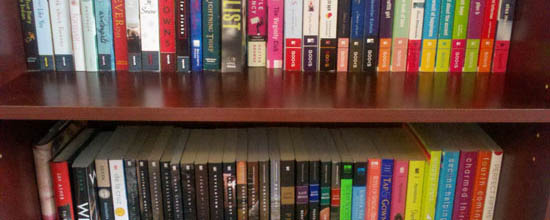I may love young adult books, but there’s no question that I’ve long passed the age of what qualifies as a “young adult.” Once upon a time, however, I was a mini version of me, and oh God did I love to read. Sure, it started with Little Bear and Frog and Toad Together, but before long, I was devouring both Sweet Valley High and the Great Illustrated Classics series that introduced me to literature greats like Robin Hood (which never failed to make me cry) and Call of the Wild. That little girl who happily curls up in any corner of a given room and shuts out the world from behind a novel? Yep, that was me. And on my less polite days, it still is.
The real glory days of reading, though, came around the time of my entrance to adolescence, when I realized that I could substitute my hardcover classics with their enormous pictures and spacing for the real thing. I didn’t have to be envious of my big sister when she gushed about the enormously important- and adult-sounding books she read; I was old enough to read those books now. So I did. Constantly. And while there were definitely some misses in the reading list, here are some of my personal hits that I will love until the end of time:
A Tree Grows in Brooklyn by Betty Smith: Cecily von Ziegesar may have dominated the aughts with her glamorization of wealth among teens, but Betty Smith’s achievement with her 1943 debut novel achieved a far more impressive task: glamorizing poverty. When I read A Tree Grows in Brooklyn in the mid-90s, fifty years after its initial publication, I wanted nothing more than to gather scraps of metal and trade them for a nickel. Francie Nolan’s life was nothing like mine, and I loved her all the more for it; if I had to pick one book from my childhood to describe as magical, this would be it.
Maniac Magee by Jerry Spinelli: Its 1990 publication date may be pushing the classification of “classic,” but this novel about a preternaturally athletic, impoverished, white-but-color-blind orphan boy who struggles to understand the racial dynamics of and his place in his divisive Pennsylvania town should, in my opinion, be required reading. Ten years later, Spinelli added yet another wonderful YA must-read to his resume with Stargirl, a celebration of individuality perfect for tweens on the cusp of adolescence.
The Catcher in the Rye by JD Salinger: Every time a bell rings, an angel argues about whether or not Salinger’s 1951 ode to teenage angst and alienation is overrated. Well, this angel is of the firm opinion that no one has better encapsulated the nostalgic malaise of not only growing up but of observing both your own loss of innocence and that of those around you, especially the younger generation, than Salinger did with Holden Caulfield. Plus, he totally made me want a little sister.
Gone With the Wind by Margaret Mitchell: One of ten-year-old me’s favorite books, it was impossible to process that the strong, seductive, and impossible manipulative Scarlett O’Hara was only six years older than I at the start of Mitchell’s iconic southern novel. Scarlett’s story and setting were transformative, and watching her do what she felt she needed to do to survive, whether or not they could truly be justified, never failed to keep me mesmerized.
Are you there God? It’s Me, Margaret by Judy Blume: Frankly, there weren’t many of Blume’s books that wouldn’t well represent my childhood, but this coming-of-age novel dealt with puberty in such a remarkably and unprecedented head-on manner that it will always stick out above the rest. Sure, it was embarrassing to read, and even more embarrassing when the boys discovered its existence, but Blume’s courage in writing this book will always, always be damn cool.
Those are my personal “classics” from childhood; please feel free to write about yours below!
